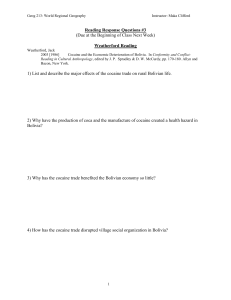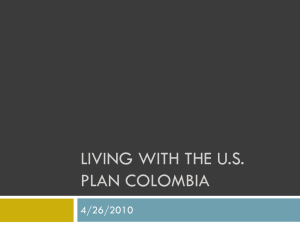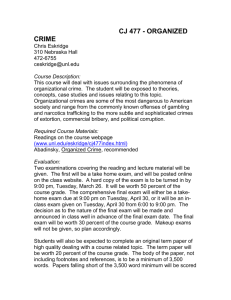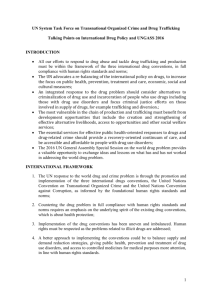The question of production of narcotics sponsoring
advertisement
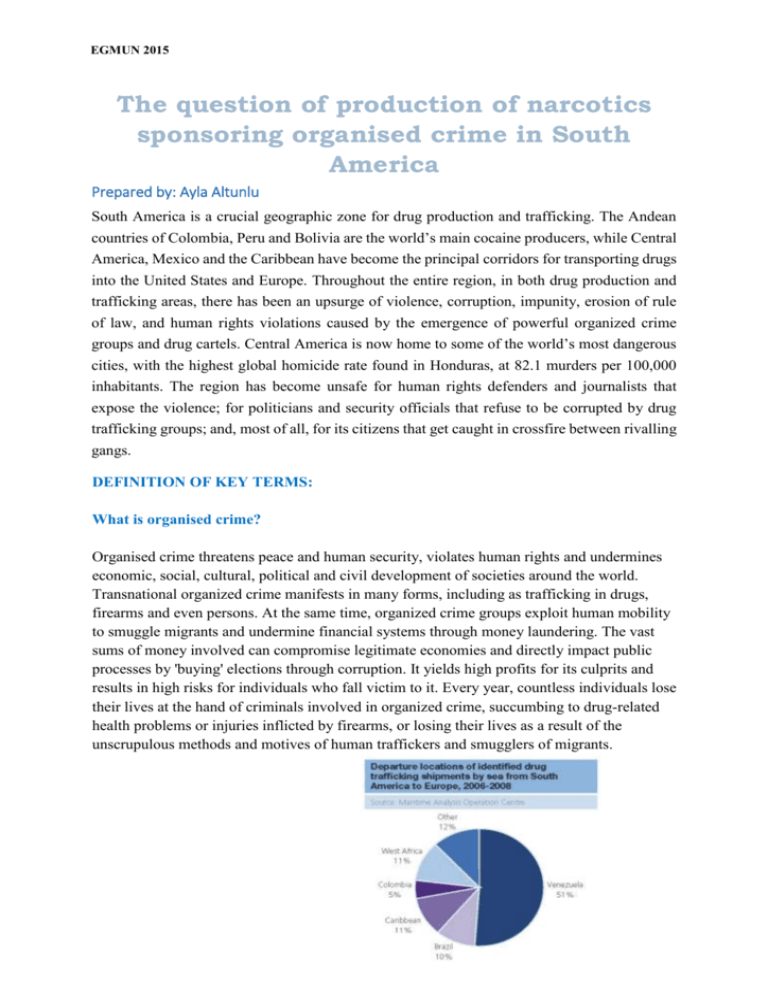
EGMUN 2015 The question of production of narcotics sponsoring organised crime in South America Prepared by: Ayla Altunlu South America is a crucial geographic zone for drug production and trafficking. The Andean countries of Colombia, Peru and Bolivia are the world’s main cocaine producers, while Central America, Mexico and the Caribbean have become the principal corridors for transporting drugs into the United States and Europe. Throughout the entire region, in both drug production and trafficking areas, there has been an upsurge of violence, corruption, impunity, erosion of rule of law, and human rights violations caused by the emergence of powerful organized crime groups and drug cartels. Central America is now home to some of the world’s most dangerous cities, with the highest global homicide rate found in Honduras, at 82.1 murders per 100,000 inhabitants. The region has become unsafe for human rights defenders and journalists that expose the violence; for politicians and security officials that refuse to be corrupted by drug trafficking groups; and, most of all, for its citizens that get caught in crossfire between rivalling gangs. DEFINITION OF KEY TERMS: What is organised crime? Organised crime threatens peace and human security, violates human rights and undermines economic, social, cultural, political and civil development of societies around the world. Transnational organized crime manifests in many forms, including as trafficking in drugs, firearms and even persons. At the same time, organized crime groups exploit human mobility to smuggle migrants and undermine financial systems through money laundering. The vast sums of money involved can compromise legitimate economies and directly impact public processes by 'buying' elections through corruption. It yields high profits for its culprits and results in high risks for individuals who fall victim to it. Every year, countless individuals lose their lives at the hand of criminals involved in organized crime, succumbing to drug-related health problems or injuries inflicted by firearms, or losing their lives as a result of the unscrupulous methods and motives of human traffickers and smugglers of migrants. GENERAL OVERVIEW 1 The illegal drug trade in South America concerns primarily the production and sale of cocaine and cannabis, including the export of these banned substances to the United States and Europe. Coca cultivation is concentrated in the Andes of South America, particularly in Colombia, Peru and Bolivia; this is the world's only source region for coca. Drug consumption in Latin America remains relatively low, but cocaine in particular has increased in recent years in countries along the major smuggling routes. As of 2008, the primary pathway for drugs into the United States is through Mexico and Central America, though crackdowns on drug trafficking by the Mexican government has forced many cartels to operate routes through Guatemala and Honduras instead. This is a shift from the 1980s and early 90s, when the main smuggling route was via the Caribbean into Florida. The United States is the primary destination, but around 25 to 30% of global cocaine production travels from Latin America to Europe, typically via West Africa. The major drug trafficking organizations (drug cartels) are Mexican and Colombian, and said to generate a total of $18 to $39bn in wholesale drug proceeds per year. Mexican cartels are currently considered the "greatest organized crime threat" to the United States. Since February 2010, the major Mexican cartels have again aligned in two factions, one integrated by the Juárez Cartel, Tijuana Cartel, Los Zetas and the Beltrán-Leyva Cartel; the other faction integrated by the Gulf Cartel, Sinaloa Cartel and La Familia Cartel. For political reasons the US Central Intelligence Agency has at times used, supported or permitted drug trafficking in Latin America in order to support certain individuals or groups. The most well-known instance is the CIA and Contras cocaine trafficking in the US, which was one aspect of what became the Iran-Contra Affair. The CIA also protected Panama President Manuel Noriega from the US Drug Enforcement Administration, until its connections with him became a liability. MAJOR PARTIES/COUNTRIES INVOLVED Argentina: Argentina is not a major drug producing country, but it remains a transit country for cocaine flowing from neighboring Bolivia, with undetermined quantities of the drug also being moved through Argentina in international transit from Peru and Colombia. Within the last several years, Argentina has become a transit area for Colombian heroin en route to the U.S. east coast (primarily New York), although there is no evidence that the quantities involved significantly affect the U.S. According to Argentine government (GOA) statistics, domestic drug use continues on the upswing. Bolivia: While notable for their significant achievements during the last four years, Bolivia’s coca eradication programs recently have had difficulties. An extremely effective eradication program had, by December 2000, eliminated most commercially viable coca production in the Chapare, previously one of the world’s largest coca producing areas. Recent changes in the government and disturbances throughout the country have slowed down net eradication and allowed farmers to replant illicit coca in the Chapare region. The Government of Bolivia (GOB) abandoned the policy of forced eradication in the Yungas region following a failed attempt to implement this policy in June. These events combined to create an overall increase in the cultivation of coca. The GOB continued interdiction efforts in the Chapare, disrupting the traffic and transit of drugs and precursor chemicals. Brazil: Brazil is not a significant producer of illicit narcotics, but it remains a major transit country for illicit drugs shipped to the U.S. and Europe and a major producer of precursor chemicals. The four main narcoticsrelated events of 2001 were the capture of major drug trafficker Fernandinho Beira-Mar, the implementation of judicial reform (drug courts), the integration of state and federal police forces (SENASP), and the implementation of a Brazil-wide national drug consumption survey. According to Brazilian authorities, the country’s domestic drug problem is increasing. Brazil continues to cooperate with its neighbors on controlling the remote border regions where illicit drugs are transported. Seizures of cocaine doubled in Brazil from 2000 to 2001, reaching eight metric tons. Chile: Chile is not a center of illicit narcotics production, but it is used as a transit country for cocaine and, more recently, heroin to the U.S. and Europe. Chile also is a source of essential chemicals for use in coca processing in Peru and Bolivia. During 2001, through close cooperation with neighboring countries, Chile achieved narcotics control successes, including seizures of Colombian heroin transiting Chile. Chile is in the midst of a criminal justice system reform which should improve its ability to prosecute narcotics offenses. Although legislative reform is planned, Chile remains vulnerable to money laundering due to strict bank secrecy laws and inadequate antimoney laundering legislation. Colombia: Colombia is the world’s leading producer and distributor of cocaine and a significant supplier of heroin to the United States. The drug trade partially finances the hemisphere’s oldest and largest terrorist group, the Revolutionary Armed Forces of Colombia (FARC), which exerts influence over a large area in southern Colombia. Some elements of the FARC have gone beyond merely “taxing” the drug trade and have taken direct steps to control local base markets. At least one FARC unit has served as a cocaine source of supply for at least one international drug trafficking organization. The paramilitary organization known as the United Self Defense Forces of Colombia (AUC) has also maintained a significant stake in the drug trade, expanding its influence from its traditional base in the north to many areas in the cocarich south that were previously controlled by the FARC. Ecuador: Ecuador is a major transit country for drugs and precursor chemicals. Armed violence on the Colombian side of Ecuador’s northern border renders interdiction especially difficult. Police and military forces are working together to improve security and curtail drug trafficking in the border area, and the Ecuadorian government is giving greater attention to drug interdiction. Drug seizures, particularly of heroin, rose sharply in 2001. Ecuador’s faulty judicial system and conflicting laws hamper prosecution of criminals. Ecuador has inadequate defense against money laundering. The USG is providing equipment, infrastructure and training to improve counternarcotics performance. U.S.-funded alternative development projects are improving community infrastructure in some of the most threatened northern areas. Paraguay: In 2001 the Government of Paraguay (GOP) continued to improve its anti-narcotics capabilities while transit of Andean cocaine through Paraguay increased. The GOP’s Anti-Narcotics Secretariat (SENAD) continued to work closely with DEA and formed a new unit, the Chaco Mobile Enforcement Team (CMET), to disrupt cocaine transit operations in Paraguay’s sparsely populated Chaco region. The SENAD’s Major Violators Unit (MVU) carried out several successful operations to disrupt cocaine networks, resulting in the arrest of a prominent drug kingpin. There was a slight increase in cocaine seizures over 2000 levels. The pertinent committees of the Chamber of Deputies approved legislation, which the Senate had previously passed, to modernize Paraguay’s anti-narcotics law. Peru: Once the world’s leading cultivator of coca leaf, Peru now ranks second in production after Colombia. While 115,000 hectares of coca were measured in 1995, manual eradication by the Government of Peru (GOP) and law enforcement-induced abandonment of cultivation by coca-growers (cocaleros) over the past six years has left approximately 34,000 hectares of coca. The bulk of this cultivation is concentrated in the Huallaga and Apurimac/Ene Valleys. However, record price levels for coca in these areas during 2001 is endangering the progress made since 1995. Moreover, reports of poppy cultivation are increasing at an alarming rate, as well as Peruvian seizures of opium derivatives. Imported designer drugs such as MDMA (Ecstasy) are also available in Peru, especially to upscale youth in the major cities. Uruguay: Uruguay is neither a major producing nor transit country for narcotics. Efforts to fight both drug trafficking and domestic consumption are effective, although law enforcement agencies and drug programs have limited resources at their disposal. Uruguay made significant efforts to combat money laundering in 2001, most notably with the expansion of the anti-money laundering law and the creation of a Financial Information and Analysis Unit in the Central Bank of Uruguay. Current areas of concern include the increased presence of marijuana in both seizures and consumption, and the lack of inspection of containers at the port of Montevideo. The Government of Uruguay (GOU) and the U.S. continue to have a cooperative relationship at both the formal and informal levels. Venezuela: Venezuela’s 2,200-kilometer border with Colombia, much of which consists of coastal deserts, mountain ranges, and remote fluvial plains largely beyond the reach of government control, offers opportunities for narcotics smuggling and production activities. A heavily transited but poorly regulated border point of entry on the Pan-American highway sees the passage of hundreds of unchecked tractor-trailers and trucks each day. The massive Orinoco river system forms two sides of Venezuela’s southwestern border, then continues north-easterly through Venezuela to the coast, at the convergence of the Atlantic Ocean and the Caribbean Sea. It has become a well-developed route for the annual shipment of an estimated 100 metric tons or more of cocaine to the U.S. and Europe. Venezuela’s unsecured seaports serve as embarkation points for multi-ton loads of cocaine secreted in cargo containers bound for the U.S. Most large containerized shipments of cocaine seized in Florida during the past decade transited Venezuelan ports. The International Narcotics Control Board (INCB): is the independent and quasijudicial control organ for the implementation of the United Nations drug conventions. UNODC: The United Nations Office on Drugs and Crime is a United Nations office that was established in 1997 as the Office for Drug Control and Crime Prevention by combining the United Nations International Drug Control Program (UNDCP) and the Crime Prevention and Criminal Justice Division in the United Nations Office at Vienna. UNODC was established to assist the UN in better addressing a coordinated, comprehensive response to the interrelated issues of illicit trafficking in and abuse of drugs, crime prevention and criminal justice, international terrorism, and political corruption. POSSIBLE SOLUTIONS Designing effective crime policies Without capable and accountable police that are responsive to the needs of the people and are backed-up by an efficient, accessible, and transparent justice system, the state cannot manage either legal or illegal economies. Why legalizing drugs is not the answer Although frequently portrayed as an effective solution to the problem of organized crime, mere legalization of illicit economies, particularly of drugs, is no panacea.Proponents of legalization as a mechanism to reduce organized crime make at least two arguments: it will severely deprive organized crime groups of resources. It will also free law enforcement agencies to concentrate on other types of crime. Professionalizing police forces Governments should professionalize their police forces. They should require well trained and equipped police, capable of investigating proficiently and using information and intelligence to perform surgical strikes against the organized mafias, tackling their structures from the top down. READ MORE http://www.insightcrime.org/newsanalysis/organized-crime-what-to-expect-in2015 https://www.unodc.org/documents/data-andanalysis/Studies/TOC_Central_America_and _the_Caribbean_english.pdf https://en.wikipedia.org/wiki/Illegal_drug_tr ade_in_Latin_America#CIA_drug_traffickin g http://www.drugpolicy.org/drug-traffickinglatin-america http://www.libertarianismo.org/livros/dmpm aehooc.pdf https://www.cia.gov/library/publications/t he-world-factbook/fields/2086.html http://www.state.gov/documents/organizat ion/8695.pdf http://www.theguardian.com/commentisfree/ 2012/apr/07/latin-america-drugs-nightmare
